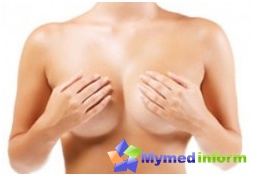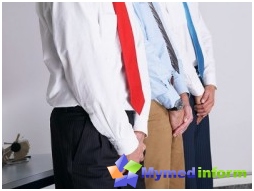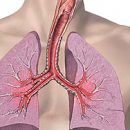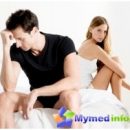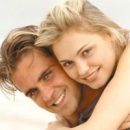Life is motion. Very nice when this movement does not interfere. However, it happened that the device itself is able to lead to a violation of the movement.
Since childhood, we, not listening to parents and teachers, slightly and misunderstood at the desk. In addition, the parties for training sessions are not always correctly chosen. We refuse to play sports or, on the contrary, perform complex physical exertion, do not respect the mode of labor and recreation. What can I say if time dictates your rules, and most of the time we spend at the computer, forgetting to take breaks.
And when we notice that something is wrong with our spine, do not rush to contact the doctor, waiting for the appearance of deterioration.
Our site offers you an article about what disease is called scoliosis, about the causes and types of scoliosis, the prevention and treatment of this disease.
What is scoliosis?
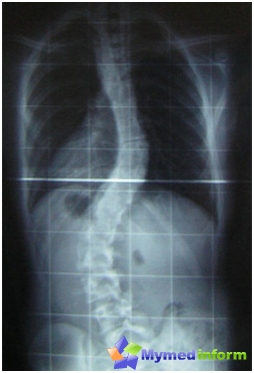
The vertebral pole consists of the vertebrae, but they, in turn, are mixed with disks. And before talking about pathology, we will deal with the norm. So, in the norm, the human spine has the following physiological curvatures:
- Bending forward in the cervical spine (cervical lordosis).
- Bending forward in the lumbar department (lumbar lordosis).
- Bending back in the thoracic spine (chest kyphosis).
- Bending back in the sacratsay (sacral kyphosis).
If the deformation occurred at least one link, we get pathological curvature, and with it also asymmetry of muscle tissues. This, in turn, leads to their uneven volume, and also has a negative impact on the internal pair authorities.
I would like to note that any deformities of the spine can cause serious violations in the work of various organs and systems, because our body is one large system in which everything is interconnected.
Scoliosis is the curvature of the spine to the left or right (relative to the frontal plane), which appears mainly at young age and progressive as the body grows.
Highlight Simple scoliosis (with one bend, C-shaped) and Comforted scoliosis (with several bends in different directions, S-shaped).
Depending on the age in which curvature appears, allocate Infantile Scoliosis (in children up to three years), Juvenile Scoliosis (from three to ten years), teenage (diagnosed in 10-15 years) and Scoliosis adults (after the cessation of spinal growth).
Causes of scoliosis formation
Various factors can lead to the appearance of scoliosis:
- Dysplasia hip joints and krivoshoy in infant age.
- Wrong posture (stuff, wearing a backpack on one shoulder).
- Rahit (due to the underdevelopment of the muscular-ligament).
- Radiculitis (scoliosis of neurogenic etiology).
- Rare physical education classes or improperly organized physical exertion (especially during spinal growth).
- Agends and various injuries.
Election of idiopathic scoliosis, in which the cause of the spinal curvature is not clear (in 80% of cases). Idiopathic scoliosis occurs in most cases in the accelerated growth phase of the skeleton. This type of scoliosis occurs in girls 5-6 times more often than boys.
As you know, treat any disease is easier, knowing the reason. However, in the case of scoliosis, knowing the general reasons for the occurrence of this disease, it is easier to prevent it, as it is often difficult to establish the origin of scoliosis.
How to recognize scoliosis?

If you suspect that scoliosis develops at your child, watch a typical posture for him (in a relaxed position). If you suspect scoliosis, ask to inspect you with another adult person who can help you establish the presence of either the lack of scoliosis on the following features.
However, no matter how you love to go to doctors, in case you are worried about the availability of scoliosis, the MPsovets recommends to turn to the doctor. Therapist, neurologist or traumatologist will examine your spine, and if it is necessary, an additional radiograph will be done (it allows you to accurately establish the degree of spinal curvature).
So, we highlight the main symptoms of scoliosis.
- In the standing position:
- At the sight of the back - explicit curvature of the spine on the parties. At the side of the side - the curvature of the spine forward (the so-called lordose scoliosis) and back (kifoscolyosis);
- different in the magnitude of the blade, asymmetry (located at different levels);
- shoulders whipped forward;
- Different levels of arrangement of shoulders;
- When tilting forward (legs are not bent in the knees) the curvature of the rib arcs is determined;
- Asymmetric arrangement of the muscles of the neck and back;
- The difference in the outlines of the waist on the right and left;
- In the position lying on the stomach (head on the chin, hands «By seam»):
- The presence of convex muscles of the back, blades, ribs;
- asymmetry buttocks;
- Legs in length differ (different thighs are possible from different sides);
- It is also possible to presence flatfoot;
- In the position lying on the back:
- thoracic deformation;
- knee joints are located at different levels;
- The shoulders write down forward.
Scoliosis classified in the degrees of gravity, of which the first are not always visible «Naked eye», and best do x-ray spine.
Severity of scoliosis and their signs
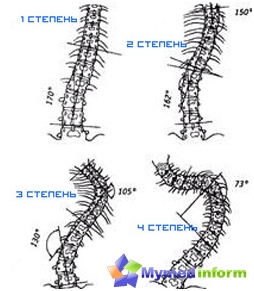
To signs Scoliosis I degree relate:
- SUTML.
- Sounded shoulders.
- From the side of the curvature of the shoulder above another.
- Updated head position.
- Asymmetry of the waist.
- Possible vertebrae around the vertical axis.
The arc of curvature is determined as follows: the patient is tilted forward and mark an arc of an octic process of felt-tip pen or green, t.To. when straightening curvature unnoticed. If the spinal X-ray is done, and the picture will be visible at an angle of 5-10 degrees, it means that you have a small scoliosis (I degree).
To signs Scoliosis II degree relate:
- The vertebrae is turned around the vertical axis (torsion).
- The contours of the neck and triangle waist asymmetric.
- Omission pelvis on the side of the curvature.
- The presence of a muscular roller in the lumbar station from the curvature, and in breast - protrusion.
Determined by curvature in any position of the body. On the radiograph of curvature at an angle of 11-30 degrees.
To signs Scoliosis III degree relate:
- The rotation of the vertebrae around the vertical axis is strongly expressed.
- Absolutely all signs of scoliosis II degree are expressed.
- It is observed by the roar hump.
- Perhaps the ribs.
- Front rib arcs drank.
- Abdominal muscles weakened.
This type of scoliosis is clearly noticeable, the snapshot shows curvature at an angle of 31-60 degrees.
To signs Scoliosis IV degree relate:
- Strong deformation of the spine.
- Strengthening all the above symptoms of spinal curvature.
- Strong stretching of muscles at the site of the spinal curvature.
- The ribs are found in a place where breast scoliosis is bent, and the roar hump.
Radiograph fixes the angle of curvature of more than 60 degrees.
Of course, great, if you read this article for general development, and all of the above did not touch you absolutely. If you still have a scoliosis, Mircelifier recommends that you do not delay.
Treatment Scoliosis

Of course, scoliosis treatment is the most effective in early childhood. But you should not ignore your hands if you decide to do it now, because it is better late than ever.
Our site convinces you to take seriously to the treatment of scoliosis and consult a doctor - orthopedic.
The treatment plan should be built on the following principles:
- Adjustment of the growth of vertebrae, which form an arc of curvature;
- Reducing the instability of the spine. In the presence of the curvature of the spine always takes place functional compensation, develop «Anti-science»;
- Elimination of this curvature, decompensation. With different degrees of the magnitude of the arc of the spine curvature, it is inevitably an increase in the smaller arc and the deviation of the case, T.E. decompensation;
- Medical and physiotherapy effects are also carried out on the entire body, which is directed to the normalization of metabolism.
The implementation of these principles in treatment is carried out in two ways: conservative or surgical.
Conservative treatment
Conservative treatment is used when the operation is not needed:
- The individual staticodynamic mode is being developed - vicious postures are excluded (contributing to the further formation of curvature), the optimal motor activity is observed, the healing gymnastics for functional correction of the spine and the chest is applied;
- The overall orthopedic regime (static unloading of the spine) is observed - for example, school classes are held on the bed with an orthopedic stand in the lying position, special orthopedic laying are used, we need to wear an orthopedic corset, sleep in a gypsum crunch;
- Medical treatment is used (non-steroidal anti-inflammatory drugs, chondroprotectors and vitaminotherapy);
- Configuring activities are held;
- Assign physiotherapy procedures (dirt, balneotherapy, exposure to low voltage current).
It is also worth adding that if scoliosis is observed in a child, it is necessary to form a conscious approach to this problem.
It is believed that the curvature of the spine axis to 10 degrees is only a violation of posture, and medical care is not required here. If the axis of the curvature is 10-20 degrees, the patient is recognized as sick scoliosis; In this case, physical exertion is limited, but special treatment is not prescribed, but only observe the patient (due to the viability of treatment).
Patients with scoliosis with the axis of curvature of 20 degrees and progression of 5 degrees per year, recommended to do three times a year X-ray spine. Special treatment is also not conducted.
Corset is appointed when the axis of the spinal curvature is 25-40 degrees.
If the axis of the spine curvature is more than 40 degrees, surgical treatment is appointed.
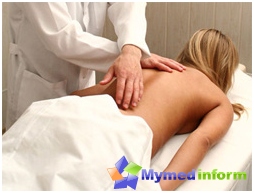
Manual therapy
With scoliotic posture, manual therapy can help - the effects of arms on the spine. The main thing is not to get into the hands of self-taught manuals, otherwise the consequences may be severe.
With the help of manual therapy, the progression of scoliosis stops, decreases with pain syndrome, the lost mobility is restored, as well as 1-2 stages, as far as possible, the pathological curvature of the spine decreases.
Separately, I want to say about Scoliotic posture. This is not yet scoliosis, but no longer the norm. Scoliotic posture occurs with the asymmetry of the shoulder belt and the pelvis, a different length of the legs, oblique position of the pelvis. This posture is accompanied by minor deviations of the spine to the right or left from its axis, disappearing at the tension of the muscles of the back. On the side of the disadvantage of the spine, the shoulders and the blades are lowered and increased triangle waist - the distance between the waist line and the hand down. On the opposite side of the contours of this triangle smoothed. Weak back muscles and abdomen.
With a scoliotic posture, a child can completely straighten the spine with the muscle tension, unlike scoliosis (from the true twist of the spine). However, if it does not take measures to correct scoliotic posture, changes in intervertebral disks and bone tissue, which are characteristic of scoliosis can occur.
Get rid of this posture, as from scoliosis at the first stages, it is possible only to the creation of a good muscular corset. Then the spine will be firmly held by the muscles in the desired position (correct). Therefore, various symmetric exercises are very useful, especially for lumbar-ileum muscles (shortening any of them can cause a scoliotic disease).
In the treatment and prevention of scoliotic posture, as well as scoliosis is greatly valid by the correct working posture. It provides a symmetric location of body parts relative to its axis. Also the child must wear different items, t.E. alternately shift them from one hand to another. It should be noted that the schoolchildren of junior classes it is desirable to wear textbooks in a routing, which would provide a uniform load on the vertebral post.
What could be if not to treat scoliosis?
Incorrect posture can lead to various diseases, such as osteochondrosis, diseases of the cardiovascular and respiratory system, diseases of the gastrointestinal tract, gender sphere, metabolic disease, Arthrosis Justov and others.
In girls during puberty, the ovarian adexites occur, hormonal disorders and menstrual cycle failures appear. This, in turn, can respond in adulthood and influence the flow of pregnancy and childbirth.
In the end, if you are in a timely manner with the treatment of your spine, you can avoid serious complications, the last degree of curvature and risky surgery for the health and life of surgical intervention.
Our site encourages you taken seriously to your health, health of your children. And once life is a movement, let it be light and painless!




